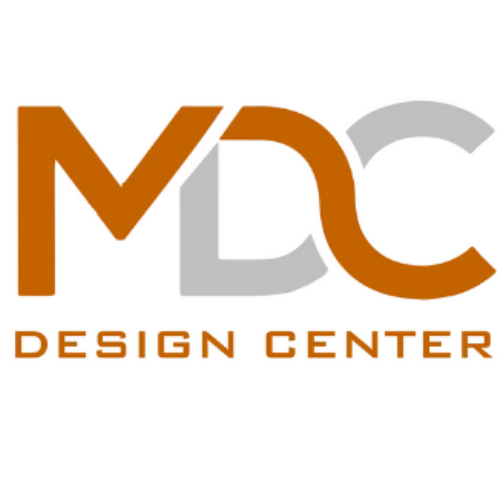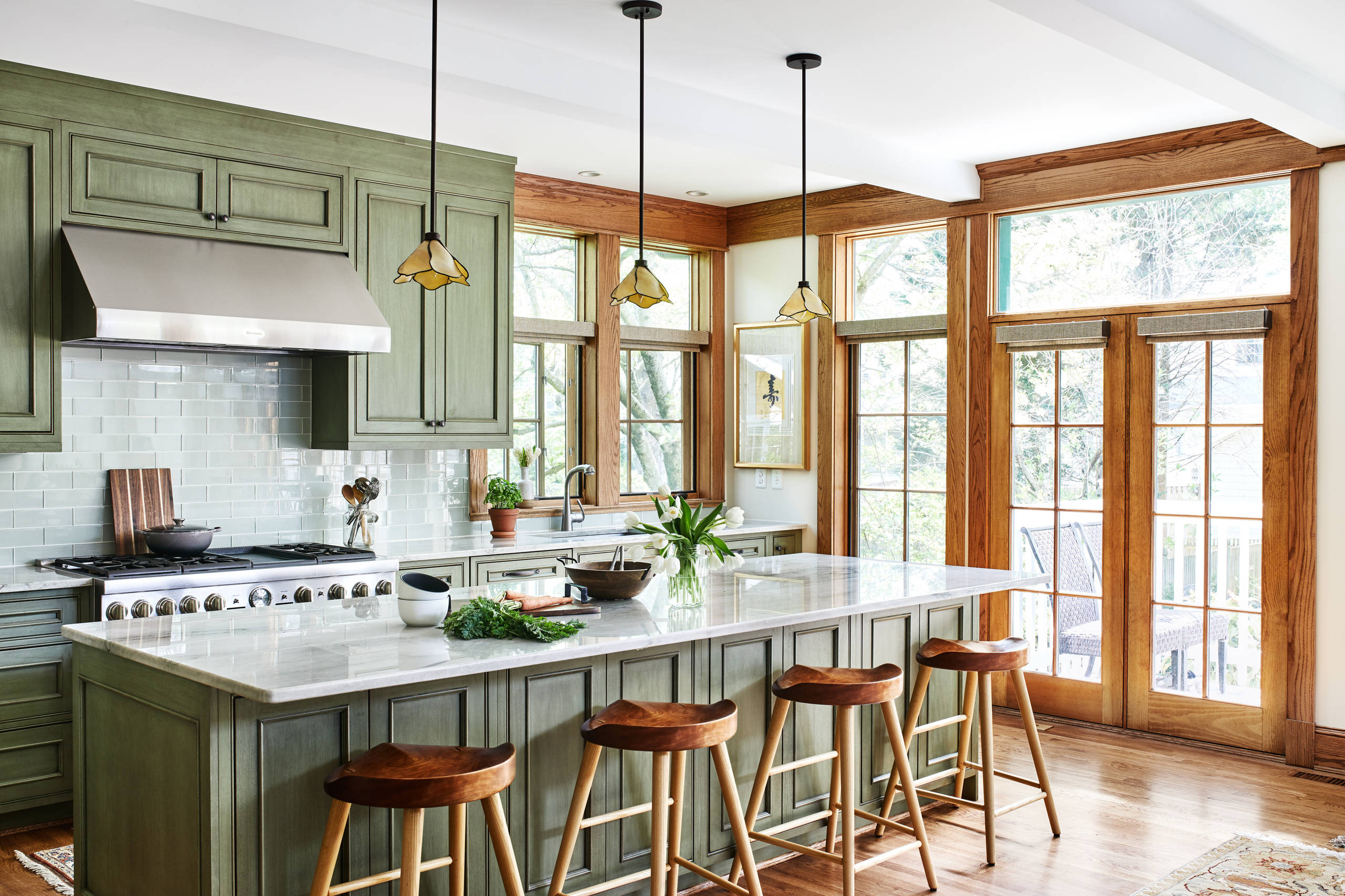Creating an eco-friendly kitchen remodel doesn’t mean sacrificing style or functionality. Today’s sustainable kitchen design combines environmental responsibility with cutting-edge aesthetics, proving that green choices can be both beautiful and practical. From energy-efficient appliances to recycled kitchen materials, modern homeowners are discovering that sustainable kitchen trends 2025 offer endless possibilities for creating spaces that are as kind to the planet as they are stunning to behold.
At MDC Design Center, we specialize in helping homeowners create environmentally conscious spaces that reflect their values while maintaining the highest standards of design and functionality. Our eco-conscious kitchen renovation expertise ensures your green kitchen transformation exceeds expectations in both sustainability and style.
Contents
- 1 The Foundation of Sustainable Kitchen Design
- 2 Green Kitchen Cabinets: Sustainable Storage Solutions
- 3 Sustainable Kitchen Countertops: Beauty Meets Responsibility
- 4 Energy-Efficient Appliances: The Heart of Green Kitchens
- 5 Water-Saving Kitchen Fixtures and Systems
- 6 Sustainable Kitchen Trends 2025: What’s Next
- 7 Low-Waste Kitchen Tips and Design Strategies
- 8 Ethical Kitchen Remodeling Practices
- 9 Indoor Air Quality and Non-Toxic Materials
- 10 Professional Sustainable Design Services
- 11 FAQ
- 12 Conclusion
The Foundation of Sustainable Kitchen Design
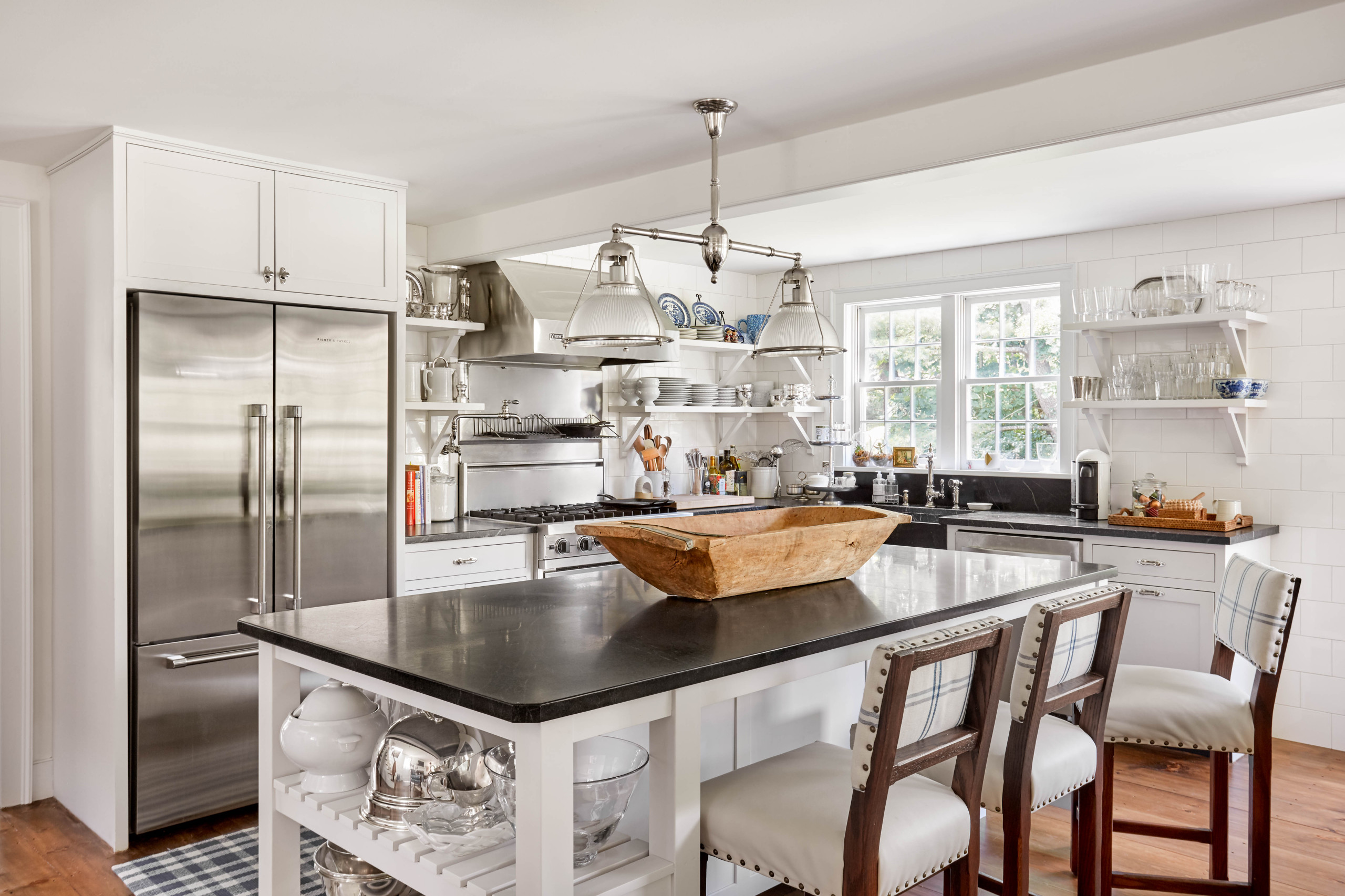
Credit: Houzz
Understanding Eco-Friendly Kitchen Principles
Sustainable kitchen design goes beyond simply choosing “green” products. It encompasses a holistic approach that considers the entire lifecycle of materials, from sourcing and manufacturing to installation and eventual disposal. The best environmentally friendly kitchen ideas integrate renewable resources, minimize waste, and prioritize energy efficiency throughout the design process.
Modern eco kitchen layout planning considers how natural light flows through the space, reducing the need for artificial lighting during daylight hours. Strategic window placement and skylights can dramatically reduce energy consumption while creating bright, inviting spaces that connect occupants with the natural world.
Life Cycle Assessment in Kitchen Planning
When planning your sustainable kitchen renovation, consider the long-term environmental impact of every choice. Non-toxic kitchen materials that last decades are often more sustainable than cheaper alternatives that require frequent replacement. This approach to green building kitchen design ensures your investment benefits both your family and the environment for years to come.
Quality sustainable materials for kitchen applications often carry higher upfront costs but provide superior durability, reduced maintenance requirements, and better indoor air quality. These factors combine to create kitchens that are truly sustainable in both environmental and economic terms.
Green Kitchen Cabinets: Sustainable Storage Solutions
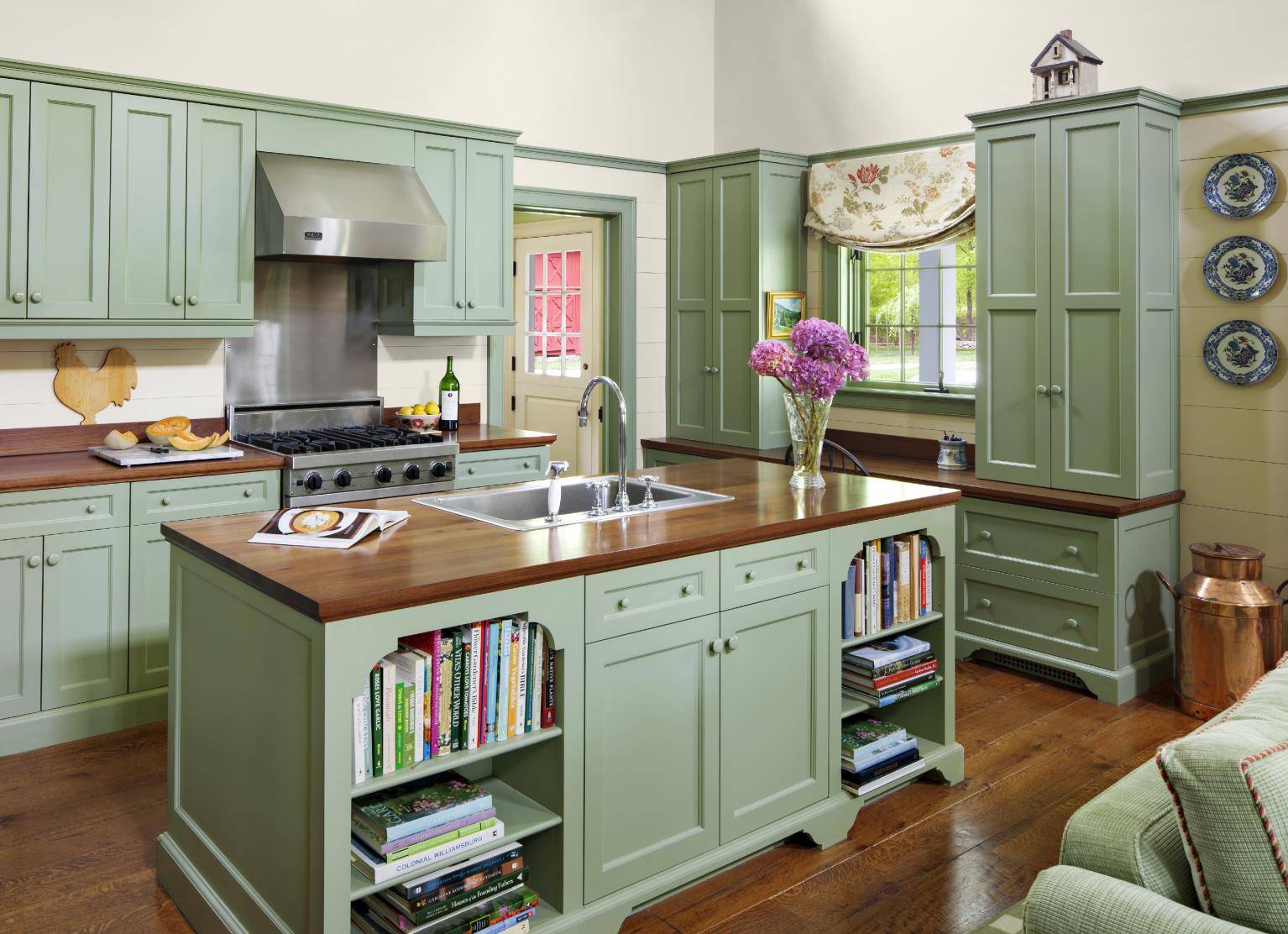
Credit: Houzz
Bamboo Kitchen Cabinets Excellence
Bamboo kitchen cabinets represent one of the most sustainable options available today. Bamboo grows incredibly quickly – some species can be harvested in just three to five years compared to decades for traditional hardwoods. This rapid regeneration makes bamboo an excellent renewable resource for cabinetry.
Modern bamboo cabinets offer exceptional durability and natural antimicrobial properties. The material’s strength rivals traditional hardwoods while providing unique grain patterns that add visual interest to any kitchen design. Bamboo’s natural moisture resistance makes it particularly well-suited for kitchen environments.
Reclaimed Wood Cabinet Options
Reclaimed wood cabinets bring character and sustainability together beautifully. Salvaged from old barns, factories, and other structures, reclaimed wood prevents valuable timber from ending up in landfills while providing unique textures and patinas that can’t be replicated in new materials.
Each piece of reclaimed wood tells a story, creating cabinets with distinctive character marks, nail holes, and weathering patterns that add authenticity to your sustainable kitchen design. Professional restoration ensures these materials meet modern standards for durability and food safety.
Low-VOC Cabinet Finishes
Traditional cabinet finishes often contain volatile organic compounds (VOCs) that can off-gas harmful chemicals into your home’s air for months or even years after installation. Sustainable kitchen cabinets use low-VOC or zero-VOC finishes that maintain indoor air quality while providing beautiful, durable protection.
Water-based finishes, natural oils, and plant-based stains offer excellent protection without compromising air quality. These eco-friendly options are available in a wide range of colors and sheens, ensuring your green kitchen doesn’t sacrifice aesthetic appeal for environmental responsibility.
Sustainable Kitchen Countertops: Beauty Meets Responsibility
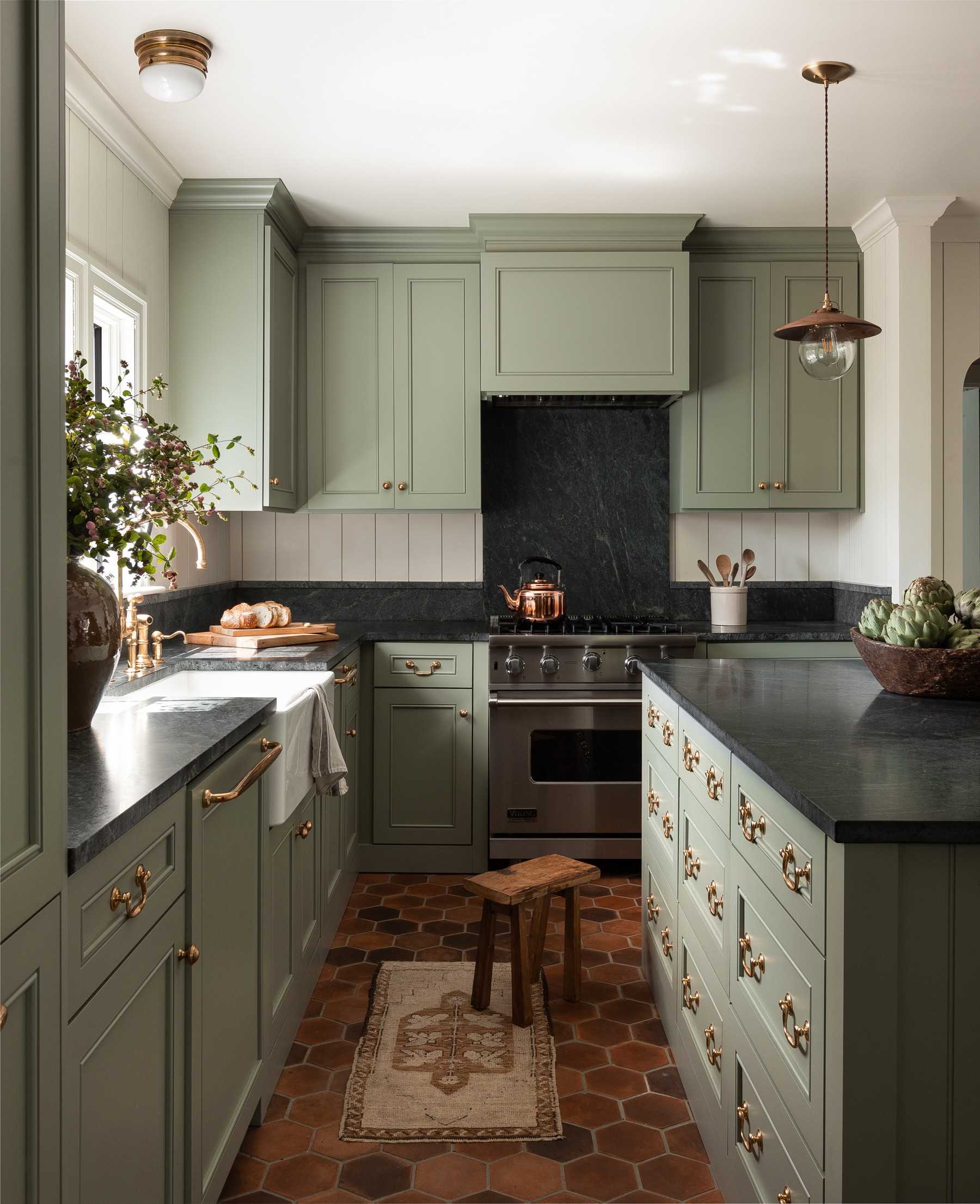
Credit: Houzz
Recycled Glass Countertops Innovation
Recycled glass countertops transform post-consumer waste into stunning kitchen surfaces. These countertops incorporate recycled glass from bottles, windows, and other sources, binding them with eco-friendly resins to create durable, non-porous surfaces that resist stains and scratches.
The visual appeal of recycled glass countertops is remarkable, with light-reflecting properties that create depth and sparkle. Available in countless color combinations, these surfaces can complement any design aesthetic while diverting waste from landfills and reducing the demand for virgin materials.
Renewable Kitchen Surfaces Options
Paper-based countertops made from recycled paper and cardboard offer surprising durability when properly sealed. These renewable kitchen surfaces provide warmth and texture while being completely renewable and biodegradable at the end of their useful life.
Concrete countertops can incorporate recycled materials like fly ash, a byproduct of coal combustion, reducing the amount of cement needed while creating unique textures and colors. Local aggregates and pigments further reduce transportation impacts while supporting regional economies.
Natural Stone Alternatives
While natural stone remains popular, sustainable alternatives offer similar beauty with reduced environmental impact. Engineered quartz surfaces often incorporate recycled content and require less energy to produce than quarrying and transporting natural stone from distant locations.
Bio-glass surfaces made from recycled glass and organic binders provide the durability of traditional stone with significantly lower environmental impact. These innovative materials demonstrate how sustainable kitchen countertops can meet the highest standards for both performance and aesthetics.
Energy-Efficient Appliances: The Heart of Green Kitchens
ENERGY STAR Certification Benefits
Energy-efficient appliances form the cornerstone of any sustainable kitchen design. ENERGY STAR certified appliances use 10-50% less energy than standard models, significantly reducing both environmental impact and utility costs over their lifetime.
Modern energy-efficient refrigerators, dishwashers, and cooking appliances incorporate advanced technologies like variable-speed compressors, soil sensors, and induction heating to maximize efficiency without compromising performance. These innovations make it easier than ever to maintain a zero-waste kitchen lifestyle while enjoying all modern conveniences.
Induction Cooking Technology
Induction cooktops represent the pinnacle of energy-efficient cooking technology. By heating cookware directly through electromagnetic fields, induction systems waste virtually no energy heating the surrounding air. This precision heating reduces cooking times while providing superior temperature control.
The efficiency gains from induction cooking are substantial – these systems are typically 85-90% efficient compared to 40-55% for gas ranges. This efficiency translates to lower energy bills and reduced environmental impact, making induction an excellent choice for sustainable kitchen design.
Smart Appliance Integration
Smart appliances optimize energy consumption by learning usage patterns and adjusting operation accordingly. Smart refrigerators can shift energy-intensive operations to off-peak hours, while smart dishwashers can select optimal wash cycles based on load sensors and soil detection.
These intelligent systems contribute to broader sustainability goals by reducing peak energy demand and integrating with renewable energy systems. When paired with solar panels or other renewable energy sources, smart appliances can operate almost entirely on clean energy.
Water-Saving Kitchen Fixtures and Systems
High-Efficiency Faucets and Aerators
Water-saving kitchen fixtures significantly reduce consumption without sacrificing functionality. Low-flow faucets and aerators can reduce water usage by 30% or more while maintaining adequate pressure for all kitchen tasks.
Touchless faucets prevent water waste by automatically shutting off when not in use. These fixtures are particularly valuable in busy kitchens where hands may be full or dirty, preventing the common habit of leaving water running unnecessarily.
Greywater Systems Integration
Advanced sustainable kitchen design can incorporate greywater systems that capture and treat water from sinks for reuse in irrigation. These systems reduce both water consumption and wastewater production, creating closed-loop water cycles that benefit both homeowners and the environment.
Greywater systems require careful planning and may need permits, but they represent the cutting edge of residential water conservation. When combined with drought-resistant landscaping, these systems can dramatically reduce a home’s overall water footprint.
Efficient Dishwasher Selection
Modern energy-efficient dishwashers use as little as 3 gallons per load compared to 27 gallons for hand washing. Selecting the right dishwasher and using it efficiently can significantly reduce both water and energy consumption in your sustainable kitchen.
Look for dishwashers with soil sensors that adjust cycle length and intensity based on actual cleaning needs. These smart features prevent over-washing while ensuring dishes come out spotless, optimizing both resource use and cleaning performance.
Sustainable Kitchen Trends 2025: What’s Next
Circular Economy Principles
Sustainable kitchen trends 2025 increasingly embrace circular economy principles, designing out waste and keeping materials in use for as long as possible. This approach influences everything from material selection to end-of-life planning for kitchen components.
Modular kitchen designs allow individual components to be updated or replaced without full renovation, extending the useful life of the overall kitchen while allowing for style updates and technological improvements over time.
Biophilic Design Integration
Biophilic design principles are becoming central to sustainable kitchen planning, incorporating natural elements that improve both environmental performance and human wellbeing. Living walls, natural materials, and abundant natural light create spaces that feel connected to nature.
Indoor herb gardens and composting systems integrate food production and waste management directly into kitchen design, supporting zero-waste kitchen lifestyle goals while providing fresh ingredients and reducing transportation impacts.
Local and Regional Material Sourcing
Sustainable kitchen trends increasingly emphasize local and regional material sourcing to reduce transportation impacts and support local economies. This approach often results in unique design elements that reflect regional character and traditions.
Local artisans and craftspeople can create custom elements using regional materials, ensuring your sustainable kitchen renovation supports community economic development while minimizing environmental impact.
Low-Waste Kitchen Tips and Design Strategies
Composting in the Kitchen Integration
Effective composting in the kitchen requires thoughtful design that makes organic waste management convenient and odor-free. Built-in compost bins, under-counter systems, and dedicated prep areas for compost collection support zero-waste kitchen lifestyle goals.
Modern compost systems can be integrated seamlessly into kitchen design, with options ranging from simple countertop containers to sophisticated electric composters that accelerate decomposition while controlling odors and moisture.
Bulk Storage Solutions
Sustainable kitchen design includes ample storage for bulk purchases, reducing packaging waste and encouraging more sustainable shopping habits. Dedicated pantry areas with airtight containers support bulk buying while maintaining food freshness and preventing pest issues.
Glass jars, stainless steel containers, and other reusable storage solutions replace single-use packaging while creating attractive, organized storage displays that enhance kitchen aesthetics.
Waste Reduction Design Features
Built-in recycling centers, reusable bag storage, and dedicated areas for cleaning and maintaining reusable items support comprehensive waste reduction strategies. These design elements make sustainable practices convenient and habitual rather than burdensome.
Consider incorporating a small sink or wash station dedicated to cleaning reusable containers and bags, making it easy to maintain these items properly and extend their useful life.
Ethical Kitchen Remodeling Practices
Fair Trade and Ethical Sourcing
Ethical kitchen remodeling extends beyond environmental considerations to include social responsibility. Fair trade materials, ethically sourced products, and suppliers with strong labor practices ensure your renovation supports positive social outcomes.
Research suppliers and manufacturers to understand their labor practices, environmental policies, and community involvement. Many sustainable material suppliers prioritize ethical business practices alongside environmental responsibility.
Supporting Local Craftspeople
Working with local artisans and craftspeople for custom elements supports community economic development while often resulting in unique, high-quality features that reflect regional traditions and skills.
Local suppliers often have lower transportation impacts and can provide more personalized service, ensuring your sustainable kitchen renovation meets your specific needs while supporting your local economy.
Waste Management During Renovation
Responsible renovation practices include comprehensive waste management plans that maximize recycling and reuse of existing materials. Deconstruction rather than demolition can salvage valuable materials for reuse in your project or donation to others.
Work with contractors who prioritize waste reduction and have established relationships with material recovery facilities, architectural salvage companies, and donation organizations.
Indoor Air Quality and Non-Toxic Materials
Formaldehyde-Free Cabinetry
Traditional engineered wood products often contain formaldehyde-based adhesives that can off-gas harmful chemicals for years. Non-toxic kitchen materials include formaldehyde-free plywood, MDF alternatives, and solid wood construction that eliminates these concerns.
No-added-formaldehyde (NAF) and ultra-low-emitting formaldehyde (ULEF) products provide the performance characteristics of traditional engineered wood without the indoor air quality concerns.
Natural Cleaning Product Storage
Sustainable kitchen design includes dedicated storage for natural cleaning products and supplies, supporting the use of non-toxic alternatives to conventional cleaners. Proper storage ensures these products remain effective while being safely accessible.
Consider incorporating a dedicated cleaning station with storage for microfiber cloths, natural cleaning concentrates, and refillable spray bottles to support sustainable cleaning practices.
Ventilation System Optimization
Effective ventilation removes cooking odors, moisture, and airborne particles while minimizing energy loss. Energy recovery ventilators (ERVs) and heat recovery ventilators (HRVs) provide fresh air while recovering energy from exhausted air.
Proper ventilation design ensures indoor air quality while supporting energy efficiency goals, creating healthier indoor environments without excessive energy consumption.
Professional Sustainable Design Services
At MDC Design Center, our sustainable kitchen design expertise helps homeowners navigate the complex world of eco-friendly materials and systems. Our kitchen remodeling services include comprehensive sustainability assessments, material sourcing assistance, and installation coordination to ensure your green kitchen renovation exceeds expectations.
Our team stays current with the latest sustainable kitchen trends 2025 and can help you balance environmental goals with aesthetic preferences and budget considerations. We work with certified sustainable suppliers and contractors who share our commitment to environmental responsibility.
Whether you’re planning a complete eco-conscious kitchen renovation or seeking to incorporate sustainable elements into a traditional remodel, our expertise ensures your project achieves your sustainability goals while creating a beautiful, functional space your family will love for years to come.
FAQ
Are sustainable kitchen materials more expensive?
While some sustainable materials have higher upfront costs, they often provide better long-term value through durability, energy savings, and health benefits. Many eco-friendly options are now competitively priced with traditional alternatives.
How much can energy-efficient appliances save on utility bills?
ENERGY STAR appliances can reduce energy consumption by 10-50% compared to standard models. For an average household, this translates to $100-500 annual savings, with larger savings possible for high-usage households.
What are the best sustainable countertop options?
Top sustainable countertop choices include recycled glass, paper-based surfaces, concrete with recycled content, and responsibly sourced natural materials. The best choice depends on your specific needs, budget, and aesthetic preferences.
Can I incorporate sustainable design on a tight budget?
Yes, many sustainable design elements are budget-friendly, including energy-efficient lighting, low-flow fixtures, and DIY projects using reclaimed materials. Prioritizing the most impactful changes first allows you to build sustainability over time.
Conclusion
Creating an eco-chic kitchen represents one of the most impactful ways homeowners can reduce their environmental footprint while enhancing their daily living experience. From bamboo kitchen cabinets and recycled glass countertops to energy-efficient appliances and water-saving fixtures, sustainable kitchen design offers countless opportunities to create beautiful, functional spaces that align with environmental values.
The sustainable kitchen trends 2025 demonstrate that environmental responsibility and design excellence are not just compatible – they’re synergistic. Green materials often offer superior performance, unique aesthetics, and better indoor air quality than traditional alternatives, proving that sustainable choices benefit both families and the planet.
As awareness of environmental issues continues to grow, sustainable kitchen design will only become more important. By choosing eco-friendly materials, energy-efficient systems, and responsible design practices today, you’re creating a kitchen that will remain relevant, valuable, and environmentally responsible for decades to come.
Ready to create your own eco-chic kitchen that combines sustainability with stunning design? Contact MDC Design Center today to explore how our sustainable design expertise can help you achieve your environmental goals while creating the kitchen of your dreams.
Sources:
- U.S. Environmental Protection Agency. “ENERGY STAR Certified Products.” EPA.gov
- Forest Stewardship Council. “Sustainable Kitchen Materials Guide.” FSC.org
- Green Building Council. “LEED for Homes Kitchen Guidelines.” USGBC.org
- Sustainable Furnishings Council. “Eco-Friendly Kitchen Design.” SustainableFurnishings.org
- Environmental Working Group. “Healthy Home Tips for Kitchens.” EWG.org
